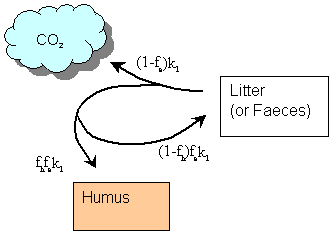Decomposition and Mineralisation - Soil organisms implicit
When soil organisms are implicit, the soil profile includes a maximum of three organic carbon pools, litter, CLitter, faeces, CFaeces, and humus, CHumus, since microbial biomass is implicit in the litter pool. Decomposition is substrate controlled and follows first-order kinetics: klCLitter for litter, kfCFaeces for faeces and khCHumus for humus, where kl, kf and kh are the specific decomposition rates. These three rate constants are affected by common response functions for soil moisture f(θ) and temperature f(T) described in the section Common abiotic functions. The efficiency parameter, fe, determines the fraction of carbon mineralised i.e. the fraction that is not released from the soil as CO2. Of the amount not being mineralised the humification fraction, fh, determines the carbon flux to humus, whereas the remaining carbon is transferred back to the litter pool as an internal cycling (i.e. the carbon taken up in the microbial biomass). The decomposition rate of the litter pool, CDecompL, is calculated as a first order rate process:
where kl is a parameter. The same first order rate equation is applied for faeces and humus, by using the parameters kf or kh and the appropriate state variables, CFaeces and CHumus.
The products of decomposition are CO2 (respiration), humus and, conceptually, microbial biomass and metabolites. Since the microbes are implicitly included in the litter and faeces pools, the synthesis of microbial biomass and metabolites constitutes an internal cycling i.e. CLitter→Litter, eq. (6.6). The relative amounts of decomposition products formed from the litter pool decomposition are (see Figure 5.1):
where fe,l and fh,l are parameters. The relative amounts of decomposition products from the faeces pool i.e. CFaeces→CO2, CFaeces→Humus and CFaeces→Faeces are calculated with the same equations exchanging the parameters to fe,f and fh,f respectively. The only flow from the humus pool is caused by respiration, CHumus→CO2, and is calculated with eq. (6.4) with the use of the efficiency parameter, fe,h.
Figure 5.1. Flow diagram showing the relative amounts of decomposition products formed.
The nitrogen fluxes associated with the carbon fluxes from litter and faeces to humus is calculated from a CN ratio representing microbes, which is given as a parameter, cnm:
The same equation applies to the nitrogen flux from the faeces pool, NFaeces→Humus, if CLitter→Humus is exchanged to CFaeces→Humus.
When soil organisms are implicit in the simulations the mineralisation/immobilization of nitrogen is dependent on the CN ratio in the source pool. Consequently, the flow from litter pool to the soil ammonium pool, NLitter→NH4, is calculated as:
where fe,l and cnm are parameters. Changing the efficiency parameter to fe,f or fe,h in addition to changing the litter CN ratio to the faeces CN ratio or the humus CN ratio, gives the flow from the faeces pool, NFaeces→NH4 or the humus pool, NHumus→NH4, respectively. A negative value of the flux means that a net immobilisation takes place. This is described in Mineralisation / Immobilisation.






